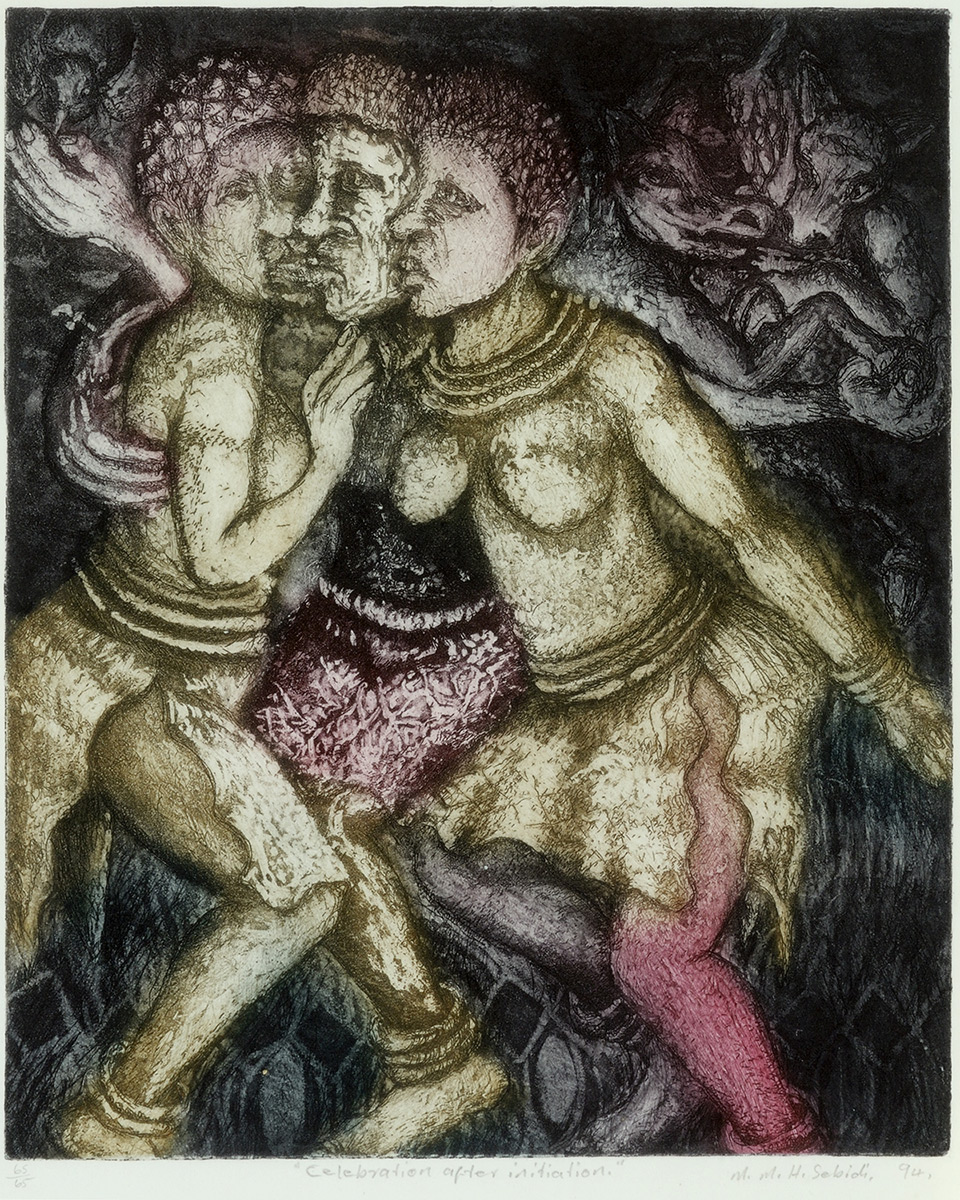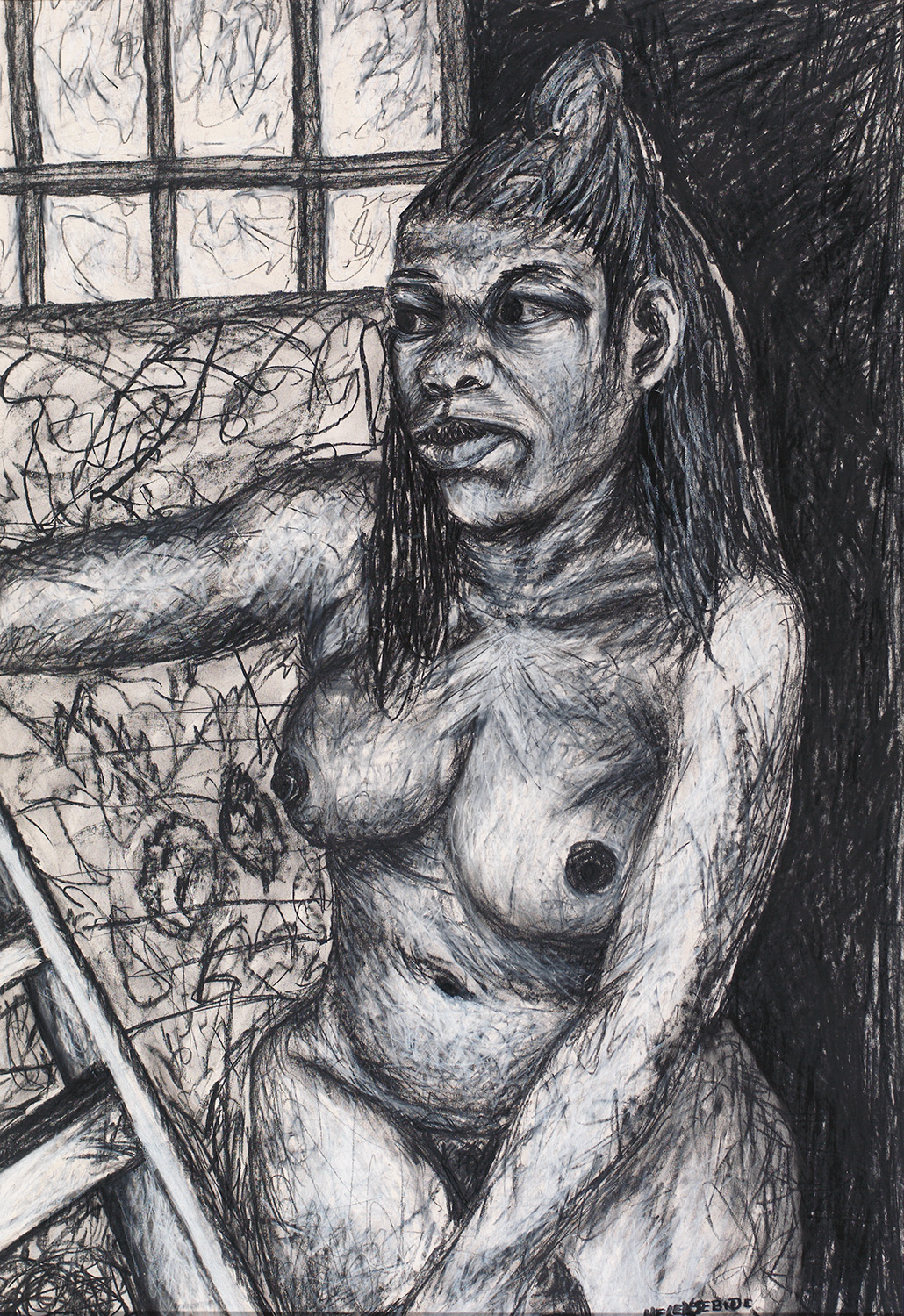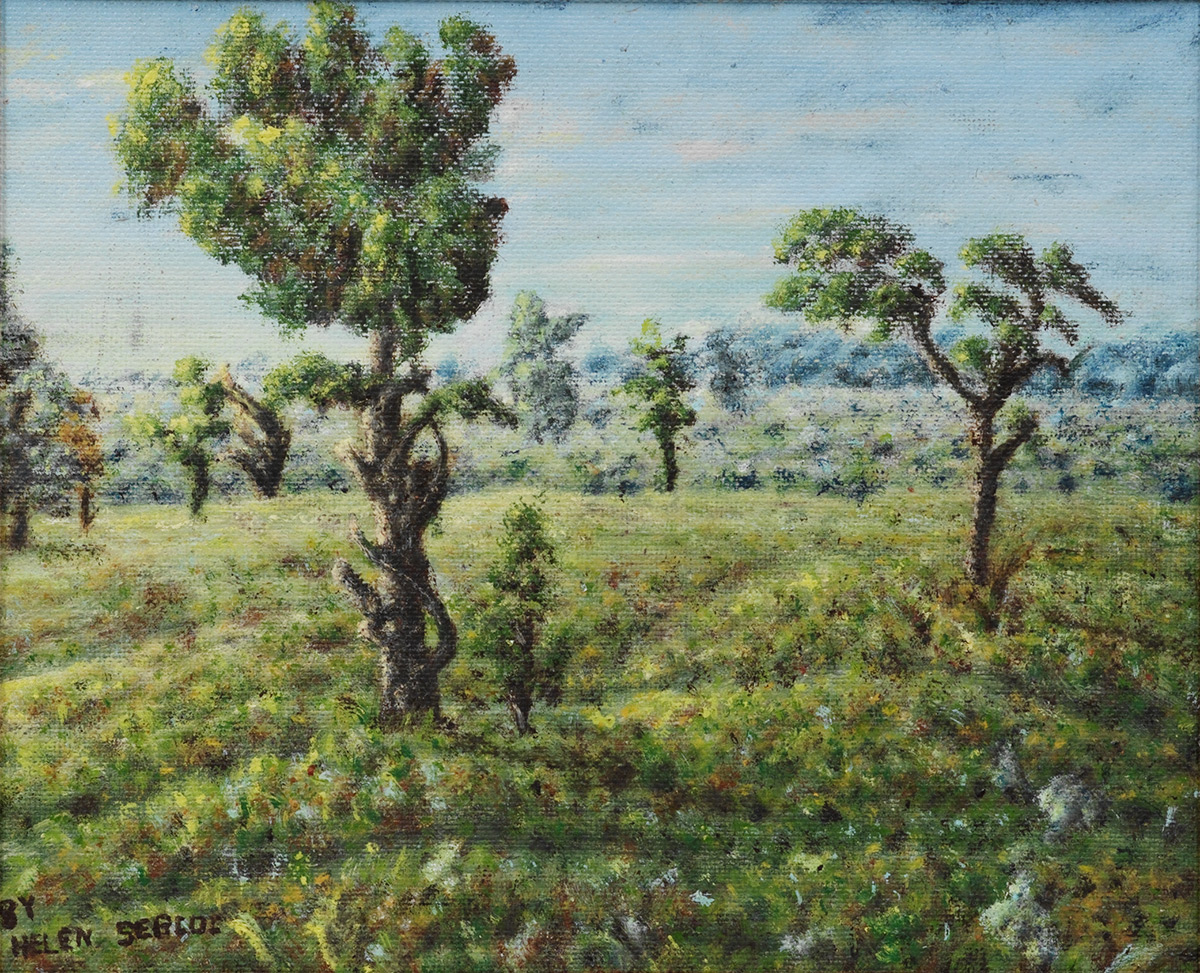‘Helen’ Mmakgabo Mapula SEBIDI (b. 1943)
Celebration After Initiation
1994
etching
45 x 38 cm
Celebration After Initiation is a figurative work, which show human bodies entwined with one another and with the bodies of non-human animals or entities. A feeling of collectivity, physicality, and togetherness prevails, with faces and limbs merging with one another in spirited moments of unfettered comingling. An animistic mood pervades Celebration After Initiation, with a tangle of birds and otherworldly creatures inhabiting the darkened space behind the three dancing figures.
The painting conveys the mood of a dream, a vision or an ecstatic celebration during which everything melts into one. The work affirms the human capacity to transcend the ongoing strife of material conditions and find faith in transcendent moments of togetherness.
‘Deeply concerned with the effects of the removal of spiritual considerations in modern day life, Sebidi at once advocates for continuous spiritual immersiveness, as well as warning of the dangers of a loss of tradition,’ writes researcher and curator Portia Malatjie in the catalogue that accompanied the Batlhaping Ba Re! the solo exhibition of Sebidi’s work that was hosted by Norval Foundation between 2018 and 2019.
A Portrait Of Sarah Tabane, Mapula
date unknown
charcoal and pastel on paper
89 x 60.5 cm
In Portrait of Sarah Tabane Sebidi invites the viewer to contemplate womanhood, and the strength and power of the female body. Flipping the western male gaze, which has commonly resulted in depictions of women lying prone and receptive, in this vigorously sketched portrait, Sebidi depicts fellow artist Kedibone Sarah Tabane (1968 – ) at work. Behind the artist is a canvas filled with doodles, which echo and extend the vigorous mark-making that constitutes Tabane’s form. Her arm is outstretched, giving the impression that she, too (like Sebidi), is in the act drawing or painting. Here, Sebidi depicts a fellow black female artist in the naked act of doing what she loves best. The mood is at once intimate and affirmative
A Little Landscape Near Bloemfontien
1977
oil on board
26.5 x 21.5 cm
A perennial theme that runs through Sebidi’s work is the politicisation of land and its material and spiritual impacts on black experience. Her love for the land and plant life is clearly evident in this landscape painting in which the trunk of the tree in the foreground appears animated with a force of upward striving.
BIOGRAPHY
Mmapula Mmakgoba ‘Helen’ Sebidi was born in Marapyane, near Hammanskraal, just north of Pretoria.
Her call to artmaking was initially sparked by her grandmother, who was a traditional wall and floor painter. Material circumstances forced Sebidi to seek work as a domestic worker in Johannesburg as a teenager, as her mother had done before her. But, in private, she pursued her artistic calling to be a painter.
In 1970, she enrolled at the White Studio in Sophiatown, established by the pioneering Black painter John Koenakeefe Mohl, where she acquired a firm grounding in the fundamentals of painting technique and composition.
The Johannesburg Artists under the Sun exhibitions in the early 1980s represented a commercial breakthrough for her.
In 1985, Sebidi took up a teaching position at the Katlehong Art Centre near Germiston.
Between 1986 and 1988, she worked for the Johannesburg Art Foundation, while teaching at the Alexandra Art Centre. She also participated in numerous community art projects, such as the Funda Art Centre and the Thupelo Art Workshop.
In 1986, Sebidi had her first solo exhibition at the Federated Union of Black Artists (FUBA), arguably the first solo exhibition for a Black female artist in the country.
In the late 1980s, Sebidi was awarded a Fulbright Scholarship, and in 1989, she was awarded the Standard Bank Young Artist Award.
Her work is exhibited regularly in major galleries across the country and abroad, and has been featured in numerous books on South African art.
Batlhaping Ba Re!, a solo exhibition of works by Sebidi from a career spanning five decades, curated by Portia Malatjie, ran at Norval Foundation in Cape Town from 2018 – 2019. Her work also featured as part of When Rain Clouds Gather: Black South African Women Artists, 1940 – 2000 at Norval Foundation (2022 – 2023). Curated by Malatjie and Nontobeko Ntombela, this group exhibition was a reflection upon the influential and often unacknowledged contributions of Black women to South African art history in the twentieth century.
Sebidi’s work was included in the watershed exhibition When We See Us: A Century of Black Figuration in Painting, which showed at Zeitz Museum of Contemporary Art Africa (MOCAA) in Cape Town from 2022 – 2023, before travelling internationally. Curated by the late Koyo Kouoh and Tandazani Dhlakama, the exhibition ‘celebrates global Black subjectivities and Black consciousness from pan-African and pan-diasporic perspectives’ and brought together artworks from the last 100 years with the words and ideas of leading Black thinkers, writers and poets who are active today.
In 2004, the South African Government bestowed on Sebidi the Order of Ikhamanga in Silver for her contribution to the field of visual and traditional arts and craft.




